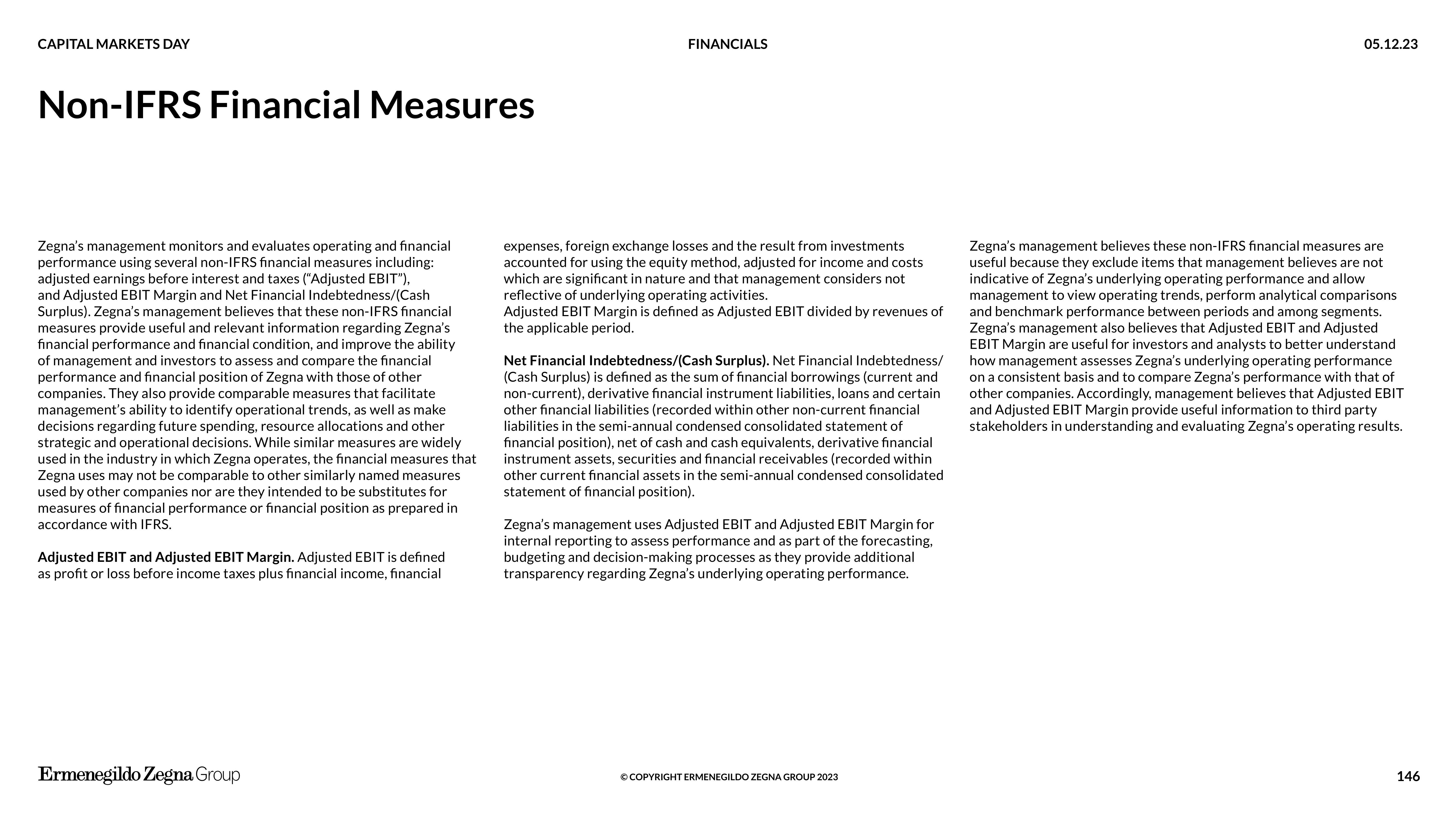Zegna Investor Day Presentation Deck
CAPITAL MARKETS DAY
Non-IFRS Financial Measures
Zegna's management monitors and evaluates operating and financial
performance using several non-IFRS financial measures including:
adjusted earnings before interest and taxes ("Adjusted EBIT"),
and Adjusted EBIT Margin and Net Financial Indebtedness/(Cash
Surplus). Zegna's management believes that these non-IFRS financial
measures provide useful and relevant information regarding Zegna's
financial performance and financial condition, and improve the ability
of management and investors to assess and compare the financial
performance and financial position of Zegna with those of other
companies. They also provide comparable measures that facilitate
management's ability to identify operational trends, as well as make
decisions regarding future spending, resource allocations and other
strategic and operational decisions. While similar measures are widely
used in the industry in which Zegna operates, the financial measures that
Zegna uses may not be comparable to other similarly named measures
used by other companies nor are they intended to be substitutes for
measures of financial performance or financial position as prepared in
accordance with IFRS.
Adjusted EBIT and Adjusted EBIT Margin. Adjusted EBIT is defined
as profit or loss before income taxes plus financial income, financial
Ermenegildo Zegna Group
FINANCIALS
expenses, foreign exchange losses and the result from investments
accounted for using the equity method, adjusted for income and costs
which are significant in nature and that management considers not
reflective of underlying operating activities.
Adjusted EBIT Margin is defined as Adjusted EBIT divided by revenues of
the applicable period.
Net Financial Indebtedness/(Cash Surplus). Net Financial Indebtedness/
(Cash Surplus) is defined as the sum of financial borrowings (current and
non-current), derivative financial instrument liabilities, loans and certain
other financial liabilities (recorded within other non-current financial
liabilities in the semi-annual condensed consolidated statement of
financial position), net of cash and cash equivalents, derivative financial
instrument assets, securities and financial receivables (recorded within
other current financial assets in the semi-annual condensed consolidated
statement of financial position).
Zegna's management uses Adjusted EBIT and Adjusted EBIT Margin for
internal reporting to assess performance and as part of the forecasting,
budgeting and decision-making processes as they provide additional
transparency regarding Zegna's underlying operating performance.
© COPYRIGHT ERMENEGILDO ZEGNA GROUP 2023
05.12.23
Zegna's management believes these non-IFRS financial measures are
useful because they exclude items that management believes are not
indicative of Zegna's underlying operating performance and allow
management to view operating trends, perform analytical comparisons
and benchmark performance between periods and among segments.
Zegna's management also believes that Adjusted EBIT and Adjusted
EBIT Margin are useful for investors and analysts to better understand
how management assesses Zegna's underlying operating performance
on a consistent basis and to compare Zegna's performance with that of
other companies. Accordingly, management believes that Adjusted EBIT
and Adjusted EBIT Margin provide useful information to third party
stakeholders in understanding and evaluating Zegna's operating results.
146View entire presentation